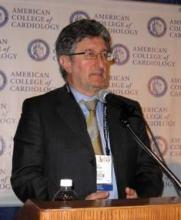CHICAGO – Implantation of a dual-chamber pacemaker effectively reduced fainting episodes in carefully selected patients with neurally mediated syncope, according to the findings of the International Study on Syncope of Uncertain Etiology-3.
"We think that after ISSUE-3, the efficacy of pacing is established and that no other randomized trials will be performed in this field to replicate the results," Dr. Michele Brignole, director of cardiology at Hospital del Tigullio in Lavagna, Italy, declared at the annual meeting of the American College of Cardiology.
ISSUE-3 was a randomized, double-blind, prospective clinical trial conducted in Europe and Canada. The study tested a specific management strategy for neurally mediated syncope (NMS) that relied upon placement of an implantable loop recorder (ILD) to document asystole as the cause of a syncopal event. Only patients with ILD documentation of a lengthy asystole were eligible to receive a pacemaker, and even then, only if they met additional clinical criteria.
Two prior clinical trials failed to show benefit for pacemaker implantation in patients with NMS. ISSUE-3 succeeded where the others failed for two reasons, in Dr. Brignole’s view: the strategy of documenting a syncopal episode with an ILD, and careful patient selection. The prior studies put pacemakers in unselected patients with NMS.
"I strongly recommend not putting in a pacemaker without documentation of the syncopal mechanism as asystole. If you don’t put in an ILD you’ll come back to the negative result of the other trials," the electrophysiologist said.
In ISSUE-3, 77 patients received a dual-chamber pacemaker and were randomized in double-blind fashion to pacemaker on or off. The primary endpoint was the occurrence of a first syncopal event during 2 years of follow-up. The rate was 25% in the pacemaker-on group, compared with 57% among those with the pacemaker off. The observed 32% absolute reduction in syncope and 57% relative reduction in syncope with pacemaker therapy were highly significant, he said.
The clinical criteria employed to define the population benefiting from pacemaker therapy included older age: Participants had to be more than 40 years old, since younger patients with NMS often experience a prodrome that enables them to head off fainting episodes through physical counter-pressure maneuvers. Indeed, the ISSUE-3 population averaged 63 years of age, with an 8-year history of NMS.
Study participants also had to have severe syncope that adversely affected their quality of life, with three or more episodes in the 2 years prior to enrollment. Most patients lacked premonitory symptoms, thus exposing them to a high risk of injury from falls. Other diseases, including carotid disease and aortic disease, were carefully ruled out.
During the screening phase of the study, 511 patients received an ILD. During up to 2 years of follow-up, an ECG-documented syncopal event occurred in 158 patients – 56% of the events were the result of asystole. Patients with syncope involving asystole lasting longer than 3 seconds or with nonsyncopal asystole for longer than 6 seconds were eligible for pacemaker implantation. The average length of asystole in study participants was 11 seconds.
Based upon this and earlier studies, Dr. Brignole estimated that 9% of patients with NMS meet the ISSUE-3 criteria for an ILD. Roughly 18% of ILD recipients would qualify for pacemaker therapy within 1 year, and 40% would qualify within 4 years.
In this select group, the number needed to treat with a pacemaker to avoid one syncopal episode in 2 years is three, he added.
Noting that one-quarter of ISSUE-3 participants experienced a syncopal event despite having their pacemaker turned on, Dr. Brignole said that the next step in the study will be a subgroup analysis to identify those patients most and least likely to benefit from this invasive device therapy.
The ISSUE-3 trial was funded by Medtronic. Dr. Brignole reported having no financial conflicts.


